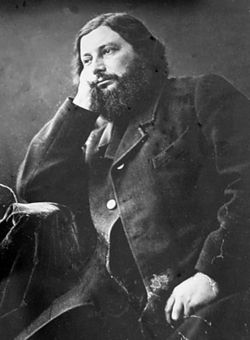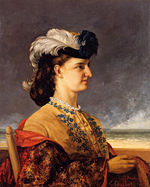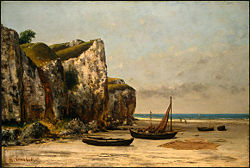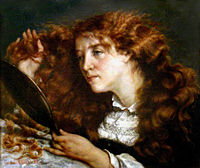Gustave Courbet
- For the French Admiral, see Admiral Courbet (1828-1885)
| Gustave Courbet | |
 Gustave Courbet (portrait by Nadar). | |
| Birth name | Jean Désiré Gustave Courbet |
| Born | 1819-06-10 Ornans, France |
| Died | 1877-12-31 La Tour-de-Peilz, Switzerland |
| Nationality | French |
| Field | Painting, Sculpting |
| Training | Antoine-Jean Gros |
| Movement | Realism |
| Famous works | Burial at Ornans (1849-1850) L'Origine du monde (1866) |
Jean Désiré Gustave Courbet (10 June 1819 – 31 December 1877) was a French painter who led the Realist movement in 19th-century French painting.
| “ | I am fifty years old and I have always lived in freedom; let me end my life free; when I am dead let this be said of me: ”He belonged to no school, to no church, to no institution, to no academy, least of all to any régime except the régime of liberty.[1] | ” |
Realism
Best known as an innovator in Realism (and credited with coining the term), Courbet was a painter of figurative compositions, landscapes and seascapes. He also worked with social issues, and addressed peasantry and the grave working conditions of the poor. His work belonged neither to the predominant Romantic nor Neoclassical schools. Rather, Courbet believed the Realist artist's mission was the pursuit of truth, which would help erase social contradictions and imbalances.
For Courbet realism dealt not with the perfection of line and form, but entailed spontaneous and rough handling of paint, suggesting direct observation by the artist while portraying the irregularities in nature. He depicted the harshness in life, and in so doing, challenged contemporary academic ideas of art, which brought the criticism that he deliberately adopted a cult of ugliness.
His work, along with the works of Honoré Daumier and Jean-François Millet, became known as Realism.
Born in Ornans (Doubs), into a prosperous farming family which wanted him to study law, he went to Paris in 1839, and worked at the studio of Steuben and Hesse. An independent spirit, he soon left, preferring to develop his own style by studying Spanish, Flemish and French painters and painting copies of their work.
His first works were an Odalisque, suggested by the writing of Victor Hugo, and a Lélia, illustrating George Sand, but he soon abandoned literary influences for the study of real life.
A trip to the Netherlands in 1847 strengthened Courbet's belief that painters should portray the life around them, as Rembrandt, Hals, and the other Dutch masters had done.
Among his early works, he painted his own portrait with his dog, and The Man with a Pipe, both of which the Paris Salon jury rejected. However, the younger critics, the Neo-romantics and Realists, loudly sang his praises, and by 1849 Courbet was becoming well known, producing such pictures as After Dinner at Ornans (for which the Salon awarded him a medal) and The Valley of the Loire.
Burial at Ornans
One of Courbet's most important works is Burial at Ornans, a canvas recording an event which he witnessed in September 1848. Courbet's painting of the funeral of his grand uncle became the first masterpiece in the Realist style. People who had attended the funeral were used as models for the painting. Previously, models had been used as actors in historical narratives; here Courbet said that he "painted the very people who had been present at the interment, all the townspeople". The result is a realistic presentation of them, and of life, in Ornans. The painting caused a fuss with critics and the public. It is an enormous work, measuring 10 by 22 feet (3.1 by 6.6 meters), depicting a prosaic ritual on a scale which previously would have been reserved for a religious or royal subject. Eventually the public grew more interested in the new Realist approach, and the lavish, decadent fantasy of Romanticism lost popularity. The artist well understood the importance of this painting; as Courbet said: "The Burial at Ornans was in reality the burial of Romanticism."
The Salon of 1850 found him triumphant with the Burial at Ornans, the Stone-Breakers (destroyed in 1945), and the Peasants of Flagey. Other figurative works, with common folk and friends as his subjects, included Village Damsels (1852), the Wrestlers, Bathers, and A Girl Spinning (1852).
Courbet associated his ideas of realism in art with Socialism, and, having gained an audience, he promoted democratic and Socialist ideas by writing politically motivated essays and dissertations.
To a friend in 1850 he wrote,
| “ | ...in our so very civilized society it is necessary for me to live the life of a savage. I must be free even of governments. The people have my sympathies, I must address myself to them directly.[2] | ” |
He displayed his monumental The Artist's Studio in 1855. It is an allegory of his life as a painter, seen as a heroic venture, in which he is surrounded by friends and admirers, among them Charles Baudelaire.
Notoriety
Towards the end of the 1860s, Courbet painted a series of increasingly erotic works, culminating in The Origin of the World (L'Origine du monde) (1866), depicting female genitalia, and The Sleepers (1866), featuring two women in bed. While banned from public display, the works only served to increase his notoriety.
On 14 April 1870, Courbet established a "Federation of Artists" (Fédération des artistes) for the free and uncensored expansion of art. The group's members included André Gill, Honoré Daumier, Jean-Baptiste Camille Corot, Eugène Pottier, Jules Dalou, and Édouard Manet.
His refusal of the cross of the Legion of Honour offered to him by Napoleon III made him immensely popular with those who opposed the current regime, and in 1871 under the revolutionary Paris Commune he was placed in charge of all the Paris art museums and saved them from looting mobs. For his insistence in executing the Communal decree for the destruction of the Vendôme Column, he was designated as responsible for the act and accordingly sentenced on 2 September 1871 by a Versailles court martial to six months in prison and a fine of 500 francs.
In 1873, the newly elected president Mac-Mahon wanted to resurrect the Column, and Courbet was singled out to pay the expenses. He then took refuge in Switzerland to avoid bankruptcy. On 4 May 1877, the estimate of the costs was finally established: 323.091 fr 68 cent. Courbet was allowed to pay the fine in yearly installments of 10,000 francs for the next 33 years, until his 91st birthday.
Courbet died, age 58, in La Tour-de-Peilz, Switzerland, of a liver disease aggravated by heavy drinking on 31 December 1877, a day before the payment of the first installment was due. (Bernard Noël, 1978)
An exhibition of his works was held in 1882 at the École des Beaux-Arts.
Pupils
- Henri Fantin-Latour
- Hector Hanoteau
- Olaf Isaachsen
See also
- History of painting
- Western painting
ReferencesISBN links support NWE through referral fees
- Nochlin, Linda, Courbet, (London: Thames & Hudson, 2007 ISBN 978-0-500-28676-0)
- Champfleury, Les Grandes Figures d’hier et d’aujourd’hui (Paris, 1861)
- Mantz, "G. Courbet," Gaz. des beaux-arts (Paris, 1878)
- Zola, Émile, Mes Haines (Paris, 1879)
- Lemonnier, C, Les Peintres de la Vie (Paris, 1888).
- Noël, Bernard, Dictionnaire de la Commune (Paris: Champs Flammarion, 1978)
- Nochlin, Linda, Realism: Style and Civilization (New York: Penguin, 1972).
- This article incorporates text from the Encyclopædia Britannica Eleventh Edition, a publication now in the public domain.
- Footnotes
- ↑ Courbet, Gustave: Letters of Gustave Courbet, 1992, University of Chicago Press, Translated by Petra Ten-Doesschate Chu, ISBN 0226116530. (Google Books)
- ↑ Courbet, Gustave: artchive.com citing Perl, Jed: Gallery Going: Four Seasons in the Art World, 1991, Harcourt, ISBN 978-0151342600.
External links
Template:Commons+cat
- General
- Courbet images and biography at CGFA
- Artchive on Courbet
- Humanities Web on Courbet
- Art Renewal Center; biography and images
- Articles and essays
- "The history of 'The Origin of the World'": an article in the TLS by Mark Hutchinson, August 8th 2007
- Courbet’s Low Tide at Trouville in the Walker Art Gallery, Liverpool
- E-zine article on Gustave Courbet
- 1867 Caricature of Gustave Courbet by André Gill
- smARThistory: Young Women from the Village
[[Category:History and biography] [[Category:]]
Credits
New World Encyclopedia writers and editors rewrote and completed the Wikipedia article in accordance with New World Encyclopedia standards. This article abides by terms of the Creative Commons CC-by-sa 3.0 License (CC-by-sa), which may be used and disseminated with proper attribution. Credit is due under the terms of this license that can reference both the New World Encyclopedia contributors and the selfless volunteer contributors of the Wikimedia Foundation. To cite this article click here for a list of acceptable citing formats.The history of earlier contributions by wikipedians is accessible to researchers here:
The history of this article since it was imported to New World Encyclopedia:
Note: Some restrictions may apply to use of individual images which are separately licensed.



